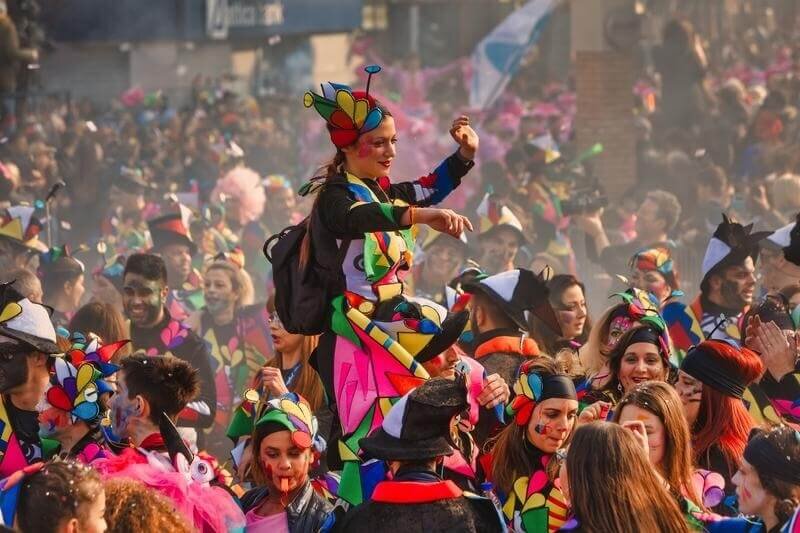Zakynthian Carnival includes dances, parties, parades and many more!
Zakynthos Guide
Our Guide
Zakynthos carnival's history
20/02/2023
The Zakynthian carnival dates back to the island's time under Venetian control.

Going unprepared to the Zakynthian carnival will lead to astonishment. The chaos on the streets makes it appear everything but Greek. Each year, for around three weeks, the entire island celebrates carnival, complete with dances, parties, parades, and theatrical performances.
The background of Zakynthos's carnival
During the island's rule by the Venetians, the Zakynthian carnival began. The Italian Commedia dell'Arte and the Venetian carnival are both supposedly parodied in it. At least one performance of the Commedia dell'Arte occurred in Crete in 1611, according to the available evidence. Zakynthos owes a great deal to the artistic, literary, and dramatic contributions of a number of Cretan artists who sought refuge there following the fall of Handakas (Heraklion) in 1669. No matter where it came from, the Zakynthian carnival looks a lot like the Venetian carnival.
At 17th-century carnivals, it was quite fine for residents to parade around town squares and streets disguised as masks. Partying was reserved for the well-to-do, while the common folk frequented "omilies."
This is the pinnacle of popular theater's use of folk songs, love tales, and satires with modern political overtones. The male and female actors were all male. Zakynthos has been selling them from the mid-seventeenth century (1. The original performance of Omilia took place in 1666 in Zante's town square; nevertheless, performances in rural areas began in 1780. The shows would usually start at noon on weekdays and early on Sundays. After the performance, two men in masks would approach passers-by on balconies and streets in an effort to collect money from the affluent. These events typically took place in front of their houses. Omilies, recitations of classical plays performed in the Zakynthian dialect, include Romeo and Julieta, Erotokritos, and Erofili, among others.
Modern observance of the tradition
Travelers from the Peloponnese and other regions of Greece would travel to the island of Zakynthos just to attend the island's famous carnival, which was well-known until the early 19th century. Subsequently, the practice dwindled in popularity until its effective revival in the past several years. The omilies are carried out in the communities beginning around Christmas. From Cheese Sunday (Kyriaki tis Tyrinis) all the way up to Thursday before Carnival (Tsiknopempti), they are performed in the carnival season.
On the Sunday of the customs officials and Pharisees, which is the fifth Sunday before Lent, Carnival officially begins every year. On Monday, they abstain from eating meat in observance of the 40 days of fasting, or "Sarakosti," which begin three weeks before carnival (carne means "flesh" and vale means "goodbye" in Latin).1. Sunday (Gurounomkyriaki - Tou Asotou)
Proclaimers parade across the streets, signaling the beginning of the Zakynthian carnival. The local festivals and old-fashioned days will follow.
Thursday (Tsiknopempti), the day before Carnival, is when the island's monarch arrives.
2. Piccolo Carnival is this Sunday.
Carnival floats through the streets.
3. (The Kyriaki and the Tyrians)
Parody drawings abound in this massive carnival procession. The "giostra," a horse-riding athletic event including elaborate costumes and masks, and the Venetian wedding are two old Zakynthian traditions that have recently been resurrected. Not to mention the return of the iconic "Gaitanaki" carnival dance. At Povero Carnival, the day comes to a close with the burying of the mask. As the magnificent funeral makes its way to the pier of the port, the carnival king is burned to death.
By the end of carnival week, hexagonal kites are sold at almost every corner. On Green Mondays, people now head to the hills to let them soar. As an additional pre-Lenten meal, a picnic will be organized, weather permitting.


